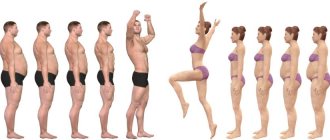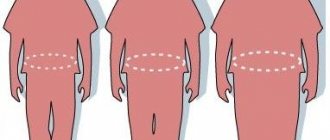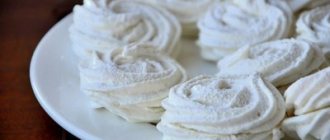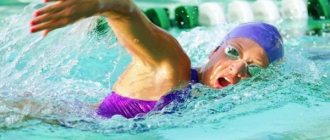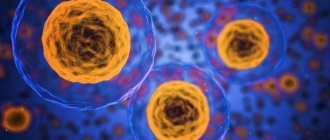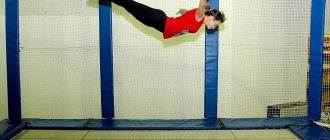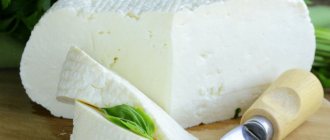Wanting to lose weight, a person wants to get rid of excess fat. However, if a person does this incorrectly, then he loses muscle mass along with fat, or gets rid of only it. To lose weight correctly, you need to understand how fat is burned in the body and through what processes this happens.
Process one. Release of fat from fat cells
Fat is located in fat cells, the number of which does not change in a person regardless of the amount of fat. That is, when losing weight, we get rid not of fat cells, but of the fat contained in them. The more it is in the cells, the greater their size and weight. Fat cells tend to stretch greatly.
Recently, scientists have proven that the number of fat cells can change throughout life, but the change is insignificant.
The first thing that happens when fat leaves the body is its release. To do this, you need to create an energy deficit in the body. Then special hormones and enzymes are released into the blood, transported through the bloodstream to fat cells and releasing fat from them.
To create an energy deficit, without which fat in the human body does not burn, you need to spend more energy than you consume. Diet restrictions and physical activity are used for this purpose.
Glycemic index of foods and weight loss
There is ample scientific evidence that nutritional systems based on low GI foods can have a positive effect on weight loss. There are many biochemical mechanisms that are involved in this, but we will name the most relevant for us:
- Low GI foods make you feel more full than high GI foods.
- After consuming foods with a high GI, insulin levels rise, which stimulates the absorption of glucose and lipids into muscles, fat cells and the liver, while simultaneously stopping the breakdown of fats. As a result, the level of glucose and fatty acids in the blood drops, and this stimulates hunger and more food intake.
- Foods with different GIs have different effects on fat breakdown during rest and during sports training. Glucose from low GI foods is not as actively stored in glycogen, but during exercise, glycogen is not burned as actively, which indicates an increased use of fats for this purpose.
| Why is whole wheat preferable to wheat flour? |
- The more crushed the product is (mostly grains), the higher the GI of the product.
- The more fiber a product contains, the lower its GI.
The differences between wheat flour (GI 85) and wheat grain (GI 15) fall under both of these criteria. This means that blood glucose levels rise more sharply after eating flour than after eating whole grains such as bulgur or spelt.
| Why do we recommend beets and other high GI vegetables? |
- The more fiber a product contains, the lower its GI.
- The amount of carbohydrates in a product is no less important than GI.
Beets are a higher fiber source of carbohydrates than flour. Although it has a high glycemic index, it is low in carbohydrates, meaning it has a lower glycemic load. In this case, despite the fact that its GI is the same as that of a grain product, the amount of glucose entering the blood will be much less. When we compare whole crops to processed ones, it is important to remember all the micro and phytonutrients that are present in natural foods that are not found in industrially processed foods.
| Why is it better to eat fresh vegetables than boiled ones? |
- The GI of raw vegetables and fruits is lower than that of cooked ones.
This rule applies not only to carrots, but also to all vegetables with a high starch content, such as sweet potatoes, potatoes, beets, etc. During cooking, a significant part of the starch is converted into maltose (a disaccharide), which is very quickly absorbed.
| Therefore, the GI of cooked foods is significantly higher than that of raw foods. |
Therefore, it is better not to boil even boiled vegetables, but to ensure that they remain whole and firm. However, if you have diseases such as gastritis or stomach ulcers, it is still better to eat cooked vegetables.
| Why do we recommend adding vegetables to proteins? |
- The combination of proteins with complex carbohydrates reduces the GI portion.
Vegetables contain dietary fiber and complex carbohydrates, which are not absorbed by the body, but are very important for effective digestion. Additionally, adding protein to any type of carbohydrate will lower the overall GI of the dish.
| Why is it better to eat an apple than to drink apple juice? |
Natural products, unlike juices, contain fiber and thereby lower the GI. Moreover, it is advisable to eat fruits and vegetables with the skin, not only because the skin contains fiber, but also because most of the vitamins are located directly on the skin.
Process two. Transporting fat to muscles and burning it
Once released from the fat cells, the fat is transformed into muscle along with the blood. Reaching the muscle, it must burn in the mitochondria, which are the so-called “power plants” of humans. And to burn fat, it needs enzymes and oxygen. If there are not enough of them in the body, fat will not be able to be transformed into energy and will be deposited in the body again.
That is, to break down fats in the human body, they need to be released from fat cells through enzymes and hormones. They are then transported to the muscle and burned through a reaction with oxygen and enzymes.
It is this process of fat breakdown that is natural weight loss. Therefore, in order for it to be correct, the body needs physical activity, accompanied by the consumption of a large volume of oxygen, and at the same time the presence of all the enzymes necessary for burning fat. To do this, you need proper nutrition with a sufficient amount of protein food, since it contains enzymes to a greater extent.
Digestion and absorption of fats[edit | edit code]
A. Digestion and absorption of fats: general information
The average intake of fats (animal and vegetable oil, margarine, milk, meat, sausages, eggs, nuts, etc.) is approximately 60-100 g per day, but there are large individual variations ( 10-250 g per day). Most fats in food (90%) are neutral fats, or triacylglycerides (triglycerides). The remaining fats are phospholipids, cholesteryl esters and fat-soluble vitamins (vitamin A, D, E and K). More than 95% of lipids are usually absorbed in the small intestine.
Digestion of fats
(A).
Lipids are poorly soluble in water, and therefore special mechanisms are required for their digestion in the aqueous environment of the gastrointestinal tract and for subsequent absorption and transport into the blood plasma. Although undegraded triacylglycerides can be absorbed in small quantities, dietary fats must be hydrolyzed by enzymes before they can be absorbed effectively. For optimal enzymatic activity, preliminary mechanical emulsification of fats is required (mainly in the distal part of the stomach), since lipid droplets in the emulsion (1-2 μm; B1) have a much larger surface area (relative to the mass of fats) for lipases to work. B. Digestion of lipids: degradation and micellization
of lipases
- enzymes that dissolve fats are produced by the glands of the tongue, fundus of the stomach (chief cells and mucous cells of the cervix) and pancreas (A). Approximately 10-30% of dietary fat is hydrolyzed in the stomach, and the remaining 70-90% is broken down in the duodenum and upper jejunum. Lipases from the tongue and stomach have an acidic pH optimum, and pancreatic lipases have a pH of 7-8. Lipases become active in the area of contact of fat (oil) with water (B). Pancreatic lipase (triacylglycerol hydrolase) exhibits lipolytic activity (maximum rate of lipolysis 140 g fat/min) in the presence of colipases and Ca2+. Procolipases from pancreatic juice, when activated by trypsin, form lipases. In most cases, pancreatic lipases break down triacylglycerides (TG) at the first and third ester bonds. This process requires the presence of water and results in the formation of free fatty acids (FFA) and 2-mono-acylglyceride.
In this case, a viscous-homogeneous phase with aqueous and hydrophobic zones (B2) is formed around the enzyme. Excess Ca2+ or deficiency of monoacylglyceride leads to the conversion of fatty acids into calcium soaps, which are then excreted.
Phospholipase A2 (formed from prophospholipase A3 of pancreatic juice when activated by trypsin) cleaves the second ester bond of phospholipids (mainly phosphatidylcholine = lectin) contained in micelles. This reaction requires the presence of bile salts and Ca2+.
Non-specific carboxylesterase (= non-specific lipase = cholesteryl ester hydrolase) from pancreatic secretions acts on cholesterol esters in micelles, as well as on all three ester bonds of TG and ester bonds of vitamins A, D, E.
This lipase is also present in human breast milk (but not cow's milk), so breastfed babies receive the digestive enzymes needed to break down milk fat in their mother's milk. Because the enzymes are heat sensitive, pasteurizing breast milk significantly reduces an infant's ability to digest milk fats.
2-Monoacylglycerides, long-chain free fatty acids and other lipids aggregate with bile acids and spontaneously form micelles in the small intestine (SI). (Because short-chain fatty acids are more polar, they can be absorbed directly and do not require bile acids or micelles.) Micelles are only 20-50 nm in diameter and have a surface/volume ratio approximately 50 times greater than lipid droplets in an emulsion. They facilitate intimate contact between fat breakdown products and the wall of the small intestine and are therefore important for lipid absorption. The polar end of the substances involved in the process (mainly conjugated bile acids, 2-monoacylglyceride and phospholipids) faces the aqueous environment, and the non-polar end faces the inside of the micelles. Completely non-polar lipids (for example, cholesteryl esters, fat-soluble vitamins and lipophilic poisons) are found inside the micelles. Thus, non-polar lipids during all these processes remain in a lipophilic environment until they reach the lipophilic brush border (microvilli) of the epithelial membranes. There they are absorbed by mucosal cells by either dissolution in the membrane or passive transport (for example, in the case of free fatty acids via transporters). Although fat absorption is complete by the time the chyme reaches the end of the jejunum, the bile acids released from the micelles are absorbed only at the end of the ileum and are then recycled (intrahepatic circulation).
Features of the process of burning fat in the body
The body has two main energy sources - glycogen and fat. Glycogen is a more powerful source and is easier to convert into energy than fat. Therefore, the body first tries to burn it, and only then does it turn to fat.
Hence, it is important that the workout lasts at least an hour, because otherwise the body, burning glycogen, may not reach fat.
Physical activity with high oxygen consumption is aerobic exercise, that is, running, cycling, swimming, and so on . It is these types of exercises that promote active fat burning, so if you want to lose weight, focus on them rather than on strength training. Strength exercises, of course, will help train muscles, but under a layer of fat they simply will not be visible.
Ideally, it is recommended to combine aerobic and strength training , since running or cycling alone will not help you get the desired result - the body tends to adapt to monotonous loads. It is thanks to alternating loads that you can achieve the desired result. Moreover, the more muscles in the body, the more actively fat is burned, so proper weight loss should include strength training.
In simple terms, fat breaks down into carbon dioxide and water, and at the same time energy is released. Carbon dioxide is excreted through the lungs, water is excreted through urine and sweat, and the body uses energy for work. This is the answer to the question of where fat goes when a person loses weight.
And one more point that misleads many. Fat is a source of energy and is distributed evenly throughout the body. It is impossible to burn it in only one area - on the stomach or legs. Therefore, when losing weight, the whole body loses weight, and in the future you can correct problem areas with strength exercises.
You also need to take into account that each person has genetic characteristics, due to which fat in specific areas can be lost better than in others.
Cholesterol (CHO)[edit | edit code]
Cholesterol esters (CHO esters), like triacylglycerides (TG), are nonpolar molecules. In the aqueous environment of the body, they can only be transported as part of lipoproteins (or associated with proteins) and can be used in metabolism only after conversion to cholesterol, which is more polar (B). CHO esters serve as storage substances and, in some cases, as a transport form of CHO. CHO esters are present in all lipoproteins, but are most abundant in LDL (42%) (A).
Cholesterol
- an important component of the cell membrane. Moreover, it is a precursor to bile salts (B), vitamin D and steroid hormones. Approximately 0.6 g of cholesterol per day is lost in feces (in the form of coprosterol) and excreted through the skin. The amount of bile acids lost per day is about 0.5 g. These losses (excluding dietary cholesterol intake) must be compensated by constant resynthesis of cholesterol in the gastrointestinal tract and liver (B). Dietary cholesterol is partly absorbed on its own and partly in esterified form (B, bottom right). Before it is reabsorbed, cholesteryl esters are broken down by nonspecific pancreatic carboxylesterase into cholesterol, which is absorbed in the upper part of the small intestine (B, bottom). Cells of the gastric mucosa contain acyl-CoA cholesterol acyltransferase (ACAT), an enzyme that re-esterifies absorbed cholesterol, so that both cholesterol and its esters can be integrated into chyl omicrons (A). Cholesterol and its CHO esters in the remnants of chylomicrons (see earlier) are transported to the liver, where lysosomal acid lipases again break down the esters into cholesterol. This cholesterol, as well as cholesterol from other sources (LDL, HDL), leaves the liver (B) in various ways: 1) by excretion into bile; 2) by conversion into bile salts, which also then enter bile; 3) by inclusion in VLDL - liver lipoproteins that export lipids to other tissues. Under the influence of LLP (see below), VLDL is converted into LPSP and later into LDL (B, left). LDL transports cholesterol and its esters to cells with LDL receptors (hepatic and extrahepatic cells; B, top). The density of receptors on the surface of cells fluctuates in accordance with cholesterol needs. Like liver cells (see above), extrahepatic cells take up LDL by receptor-mediated endocytosis, and lysosomal acid lipases convert cholesteryl esters to cholesterol (B, top right). Cells can then incorporate cholesterol into cell membranes or use it to synthesize steroids. Excess cholesterol causes (a) inhibition of cholesterol synthesis in cells (3-HMG-CoA reductase) and (b) activation of ACHAT, an enzyme that sterifies and stores cholesterol in the form of its esters.
Hyperlipoproteinemia[edit | edit code]
Excess blood lipids may reflect increased levels of triacylglycerides and/or cholesterol (> 2.0–2.2 g/L serum, found in approximately one in five Westerners). In its most serious form, familial hyperlipoproteinemia (a genetic defect) causes increased concentrations of cholesterol in the blood from birth, which can lead to myocardial infarction in adolescence. The disease is caused by a genetic defect in high-affinity LDL receptors. Serum cholesterol levels rise as cells take up small amounts of cholesterol-rich low-density lipoprotein (LDL). Extrahepatic tissues synthesize large amounts of cholesterol because 3-HMG-CoA reductase cannot inhibit cholesterol synthesis due to decreased absorption of LDL. As a result, more and more LDL binds to low-affinity receptors that mediate the absorption and storage of cholesterol in macrophages, skin and blood vessels. Thus, hypercholesterolemia increases the risk of atherosclerosis and coronary heart disease.
How fat is stored in the body
You also need to understand how fat is formed in the human body. The presence of fat deposits on the human body is a normal indicator of the body’s protective reaction, or more precisely, a natural survival mechanism. In ancient times, it was thanks to fat that a person could survive in severe cold. Today there is no such need, but fat still accumulates. How does this happen?
First of all, carbohydrates, especially simple sugars, are transformed into fat cells. Of course, like other substances, the body needs them. They are deposited in the muscles, and this becomes the main source of energy for strength work, and for any load in principle. But the maximum amount that can accumulate in the muscles is 60-90 grams of carbohydrates, and another 70-80 grams can be deposited in the liver. There are no other places for their storage in the body. Therefore, when carbohydrates are consumed in excess of the norm, they are transformed into fat deposits and “settle” on the stomach, hips, legs and other parts of the body.
Another point is that fat can be drawn directly from fat . The body also needs fats, especially women to maintain the functioning of the hormonal, reproductive and cardiovascular systems. However, a gram of pure fat contains about 9 kcal, respectively, 100 grams of it - 900 kcal, and this is not so far from the daily calorie intake of a person who wants to lose weight. Calories from fat are stored by the body easier and faster than those coming from carbohydrates, since fat is difficult to break down and is the last source of energy to be used.
Where and how is fat accumulated in the body? Many people think that it is deposited only under the skin, since these deposits can be seen with the naked eye. Most of it actually accumulates here, but the skin-fatty tissue is located not only directly under the skin, but also inside, enveloping the internal organs, which is necessary to protect them. This type of fat is called visceral or abdominal , since the most important organs are located in the abdominal or sternum areas. But if the amount of subcutaneous fat exceeds the norm, this is fraught with obesity, disturbances in the functioning of the cardiovascular system and the resulting numerous negative consequences.
Distribution and storage of fats[edit | edit code]
A. Lipoproteins
Lipids in the blood are transported in the form of lipoproteins, lipoproteins (A), which are aggregates of molecules (microemulsions) with a central part of highly hydrophobic lipids, such as triacylglyceride (TG) and cholesterol esters (CHO esters), surrounded by a layer of amphipathic lipids (phospholipids, cholesterol). Lipoproteins also contain some types of proteins called apolipoproteins. Lipoproteins vary in molecular size, density, lipid composition, as well as sites of synthesis and composition of apolipoproteins. Apolipoproteins (Apo) function as structural elements of lipoproteins (e.g., ApoAII and ApoB48), ligands of lipoprotein receptors (ApoB100, ApoE, etc.) on the membrane of lipoprotein target cells, and activators of enzymes (e.g., ApoAI and ApoCII).
Chylomicrons transport lipids (mainly triacylglycerides, TG) from the intestine to the periphery (via intestinal lymph and systemic circulation; D), where their ApoCII activate endothelial lipoprotein lipase (ELL), which cleaves free fatty acids (FFA) from TG. FFA is mainly absorbed by myocytes and fat cells (D). With the help of ApoE, chylomicron remnants deliver the remaining triacylglycerides, cholesterol, and cholesteryl esters to hepatocytes via receptor-mediated endocytosis (B, D).
Cholesterol and TG, imported from the intestine, as well as synthesized in the liver, are exported as a fraction of VLDL (very low density lipoprotein) from the liver to the periphery, where they also activate LPSP with the help of ApoCII, leading to the release of FFA (G). This leads to loss of ApoCH and exposure to ApoE. Remnants of VLDL or LPSP (medium or intermediate density lipids) remain. Approximately 50% of LPSP returns to the liver (mostly bound to ApoE at LDL receptors; see below), where LPSP is reprocessed and exported from the liver as VLDL (B).
B. Metabolic pathway of cholesterol
The other 50% of LPSP is converted to LDL (low-density lipoprotein) after contact with liver lipase (resulting in loss of ApoE and ApoB100 exposure). Two-thirds of LDL deliver cholesterol and cholesteryl esters to the liver, and the other third to extrahepatic tissues (B). The binding of ApoB100 to LDL receptors is required for both processes.
High-density lipoproteins (HDL) exchange some apoproteins for chylomicrons and VLDL and absorb excess cholesterol from extrahepatic cells and blood (B). Together with ApoA1, they activate plasma lecithin-cholesterol acyltransferases (LCAT), which are responsible for the partial esterification of cholesterol. HDL also delivers cholesterol and its esters to the liver and glands that produce steroid hormones and have HDL receptors (ovaries, testes, adrenal cortex).
Features of proper fat burning
Subcutaneous fat tissue disappears quite quickly. But visceral fat is burned more difficult and slower. But it is very important to fight its excess to maintain the normal functioning of the body and all its systems.
Initially, proper nutrition is important, since fat is burned when there is a lack of energy. You need to start by counting calories. You can eat fully, consuming all the necessary substances, however, reduce calories to 1500-1800 kcal per day for women, and 2000-2300 kcal for men. First of all, of course, it is important to reduce the amount of fatty foods in your diet. Sources of fats should be healthy: sea fish, vegetable oils, nuts . It is also important to limit simple carbohydrates such as sugar, sweets, baked goods, and sugary waters. Sources of carbohydrates should be healthy - cereals, fruits and vegetables, whole grain bread.
Workouts, namely aerobic exercise, are very important for proper fat burning. They provide the best supply of oxygen to the body, and it is he who is the main assistant in burning fat. And don’t forget that cardio training should last at least 30-40 minutes so that the body uses up glycogen and has time to get to fat.
In fact, any exercise will be effective for burning fat, and you can choose the ones that you like best. How much you burn will be determined by the intensity of the workout, physical fitness, age - the older the person, the longer the storage systems work, muscle mass. The frequency of training is also important.
If we are talking about cardio training, then you can add such effective exercises as running in place with high knees, jumping with legs and arms, burpees and others.
Even exercises such as squats and push-ups can be performed in cardio mode if done at an accelerated pace. You can do a certain amount per approach or do it for a while, improving your results each time. This will turn your workout into high-intensity interval training.
Regardless of the circumstances, you need to give your best. The more and more actively you work, the more energy is consumed. But the entire process of fat burning, in fact, comes down to the ratio of energy received and energy spent. If you eat right, you will get results as quickly as possible.
Another option for burning fat is running. Also remember that strong muscles cause the body to expend more energy, so strength training is also necessary. It is important to alternate the load and make the workouts varied so that the body does not get used to monotony.
Knowing how the process of breaking down and burning fat occurs, you can achieve better results. Remember that the most important thing is to exercise regularly and eat in moderation so that the body does not receive excess, which it will rush to store as fat.
